AC vs. DC Electric Motors: What’s the Difference?
17/12/2024

Sam Nie
Hello every one. This is Sam Nie, the CEO of LUPMOTORS. With 10 year's technical and manufacture experience in the field of 3-phase electric motor, I can provide you definitive guides in the knowledge of 3-phase industrial electric motors,which will help you a lot in selecting electric motors for your applications.
Ever wondered why some motors hum away quietly in factories while others power the gadgets in your home? It’s all about the type of current they use—alternating or direct.
AC (alternating current) and DC (direct current) motors are at the heart of modern machines. From running heavy-duty industrial equipment to powering your electric toothbrush, these motors are everywhere. They work differently, excel in unique ways, and play critical roles in shaping technology.
As an engineer, I’ve spent years working with both types of motors. In this article, I’ll tell you their key differences in simple terms. By the end, you’ll know not just how they work, but also which one suits your needs best—whether it’s for a factory setup or a DIY project.
Let’s get started.

AC motors and DC motors each have their unique strengths and applications. Throughout this article, we’ve explored their working principles, structural differences, advantages, and real-world applications. To help you make an informed decision, here’s a clear comparison of their key factors:
Now, Let’s explore the differences one by one.
| Factor | AC Motors | DC Motors |
|---|---|---|
| Power Source | Alternating current (grid or generator) | Direct current (battery or rectified DC supply) |
| Efficiency | High efficiency at steady loads (up to ~96%) | High efficiency in variable-speed applications (~85–90%) |
| Torque | Low starting torque | High starting torque |
| Speed Control | Requires a VFD for precise control | Controlled directly by adjusting voltage |
| Structural Complexity | Simple, fewer components (stator, rotor) | More complex with brushes and commutators (in brushed types) |
| Maintenance | Low maintenance | Higher maintenance for brushed motors; low for brushless |
| Cost | Lower initial cost | Higher initial cost (especially brushless motors) |
| Applications | Industrial machinery, HVAC systems, conveyor belts | Electric vehicles, robotics, handheld tools |
| Technological Innovations | IoT-enabled VFDs, recyclable components | Brushless DC motors, rare-earth magnets |
| Suitability | Best for continuous, large-scale operations | Ideal for portable, dynamic, and precision applications |
Table of Contents

1. What Are AC and DC Electric Motors?

1.1 AC Electric Motors

1.1.1 Working Principle of AC Motor
AC motors operate on the foundation of Faraday’s principles of electromagnetic induction, which state that a changing magnetic field induces an electric current in a conductor. Nikola Tesla, often called the father of AC motors, revolutionized this principle by inventing the rotating magnetic field, the core concept behind AC motor operation.
Here’s how it works:

The coils in the stator, the stationary outer part of the motor, receives alternating current (AC). This current creates a changing magnetic field that rotates around the stator. This rotating magnetic field induces a current in the rotor, the motor’s rotating part, through electromagnetic induction. The interaction between the rotating magnetic field in the stator and the current in the rotor generates torque, causing the rotor to spin.
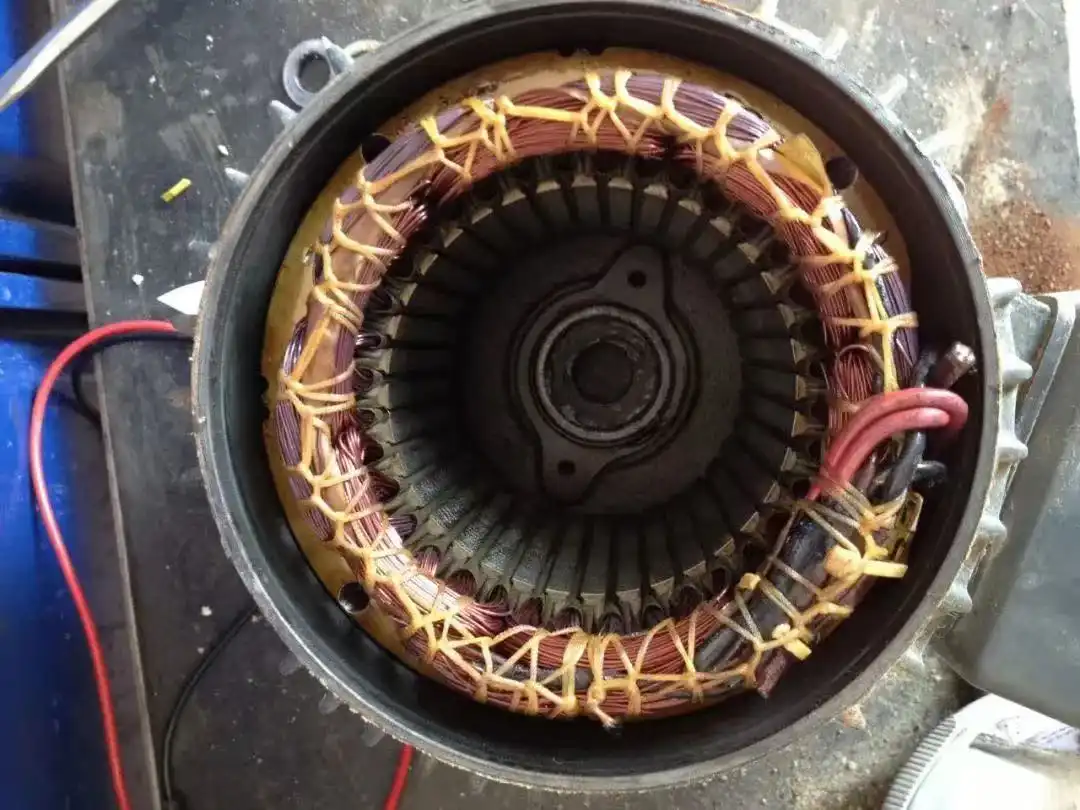
The Motor stator coil

The Motor Rotor
The beauty of Tesla’s innovation lies in the rotating magnetic field, which eliminates the need for brushes or commutators, simplifying the AC motor’s design and making it more durable.
In summary, AC motors convert electrical energy into mechanical motion using Faraday’s electromagnetic principles, with Tesla’s rotating field concept enabling smooth, efficient, and continuous rotation.
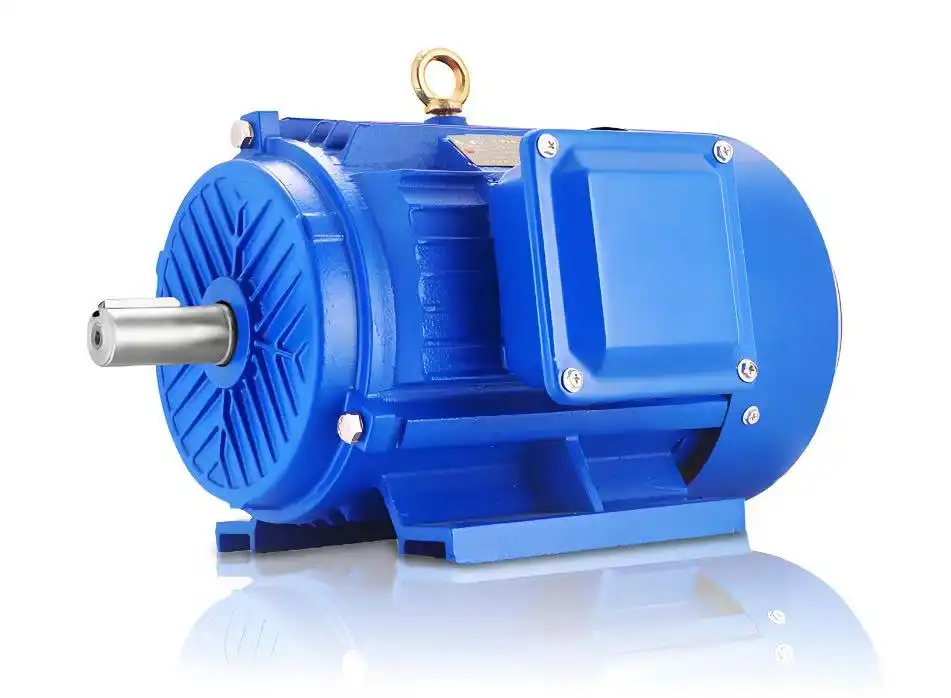

1.2 DC Electric Motors

1.2.1 Working Principle of DC Motor
DC motors work on a simple principle: when an electric current passes through a conductor placed in a magnetic field, it experiences a force that causes motion. This is known as Lorentz Force.
Here’s how it works:

In a DC motor, the armature (a coil of wire) is placed inside a magnetic field generated by permanent magnets or field windings. When direct current flows through the armature, it generates a magnetic force that interacts with the existing magnetic field, producing torque to turn the rotor.
Now, here’s where commutation comes into play:
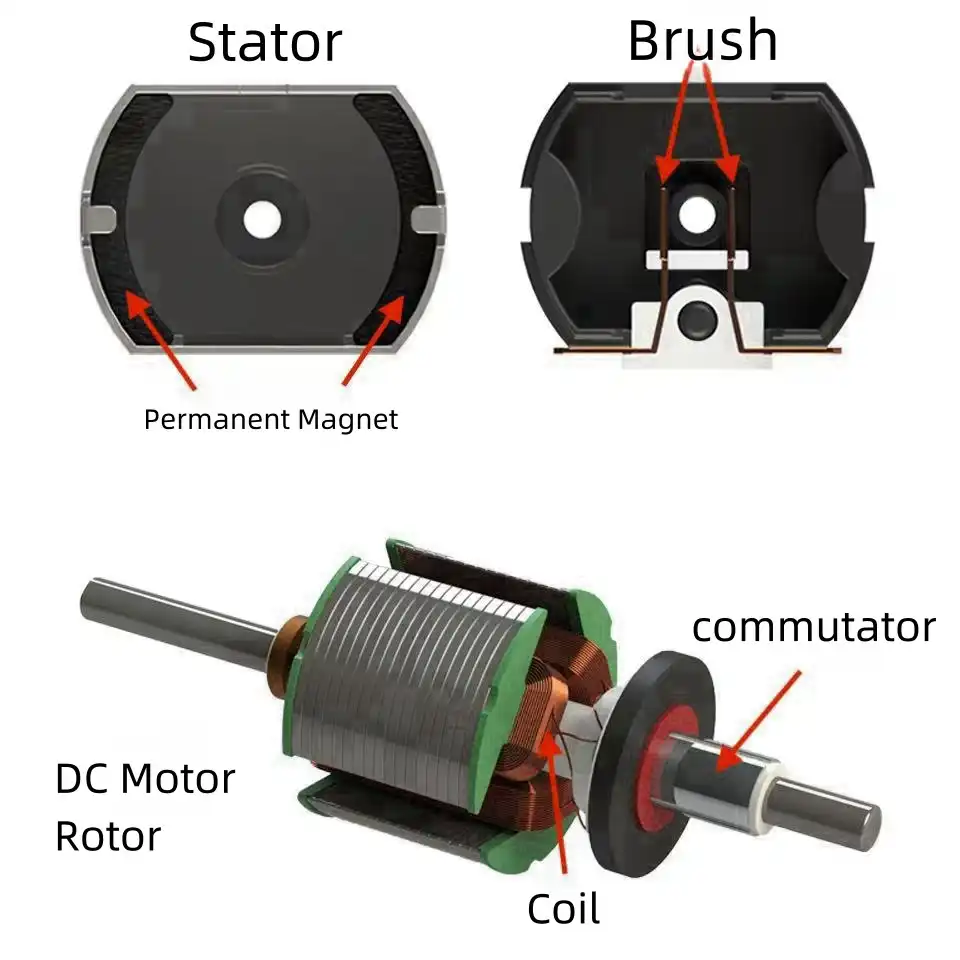
Without commutation, the armature would align with the magnetic field and stop rotating. To keep the rotor spinning, the commutator—a segmented ring—reverses the current flow in the armature coils at precise moments.
This process ensures the magnetic field in the armature always repels or attracts the field magnets, maintaining continuous rotation. The brushes, which make contact with the commutator, deliver the current but wear down over time due to friction.
In short, commutation is the heart of a DC motor’s operation, converting direct current into the motion you see—smooth, consistent, and full of torque.

1.1.2 Key Components of AC Motor
- Stator: The stationary outer shell that generates the magnetic field.
- Rotor: The rotating inner core driven by the magnetic forces.
- AC Power Source: Provides the alternating current necessary for operation.

1.2.2 Key Components of DC Motor
- Brushes: These deliver current to the rotating armature via the commutator.
- Commutator: A segmented ring that switches the direction of current to maintain rotation.
- Magnetic Field: Created by either permanent magnets or electromagnets, it drives the interaction that produces torque.

1.1.3 Types of AC Motorsr

1.Synchronous Motors
Click it for more contents
These operate with the rotor speed matching the stator's magnetic field rotation.

2. Induction Motors
Click it for more contents
Here, the rotor lags slightly behind the rotating magnetic field, creating the needed torque.

Synchronous Motor

Induction Motor

1.2.3 Types of DC Motors

1.Brushed DC Motor
Click it for more contents
These are the traditional type, featuring brushes and a commutator. They are simple, cost-effective, and easy to control. However, brushes wear out over time, requiring maintenance.

2.Brushless DC Motor (BLDC)
Click it for more contents
In these motors, electronic controllers replace the brushes and commutator. They are quieter, more efficient, and have a longer lifespan. BLDC motors are widely used in modern applications like drones and electric vehicles.

Brushed DC Motor

Brushless DC Motor
Tip: To get more knowledge about the working principle of electric motor, please read this article.
Tip: To get more knowledge about the stator and rotor of electric motor, please read this article.
Video Resources
Tip: These 2 videos will illustrate the Working Principle of AC & DC Motors.

Quiz: Test Your Knowledge of Part 1: What Are AC and DC Electric Motors?
1. Which fundamental principle explains the operation of both AC and DC motors?
- A) Ohm’s Law
- B) Ampere’s Law
- C) Faraday’s Law of Electromagnetic Induction
- D) Newton’s Third Law of Motion
2. What is the role of the commutator in a DC motor?
- A) It creates the magnetic field.
- B) It reverses current direction to ensure continuous rotation.
- C) It reduces friction inside the motor.
- D) It provides power to the rotor.
3. What key component of AC motors generates the rotating magnetic field?
- A) Rotor
- B) Commutator
- C) Stator
- D) Brushes
4. Which of the following is a primary difference between AC and DC motors?
- A) AC motors rely on alternating current, while DC motors rely on direct current.
- B) AC motors require brushes, while DC motors do not.
- C) DC motors use variable frequency drives for speed control.
- D) AC motors generate higher starting torque than DC motors.
5. Who is credited with pioneering the concept of the rotating magnetic field in AC motors?
- A) Michael Faraday
- B) Thomas Edison
- C) Nikola Tesla
- D) James Clerk Maxwell
Learn More about Electric Motors?
LUPMOTORS will send you articles to your Email every week.
100% Free! No Credit Card!

2. Key Differences Between AC and DC Electric Motors

2.1 Power Source
The biggest distinction lies in how they’re powered.

AC Motors
These motors are powered by alternating current, which means the flow of electricity periodically reverses direction. They typically draw power directly from the grid or a generator.
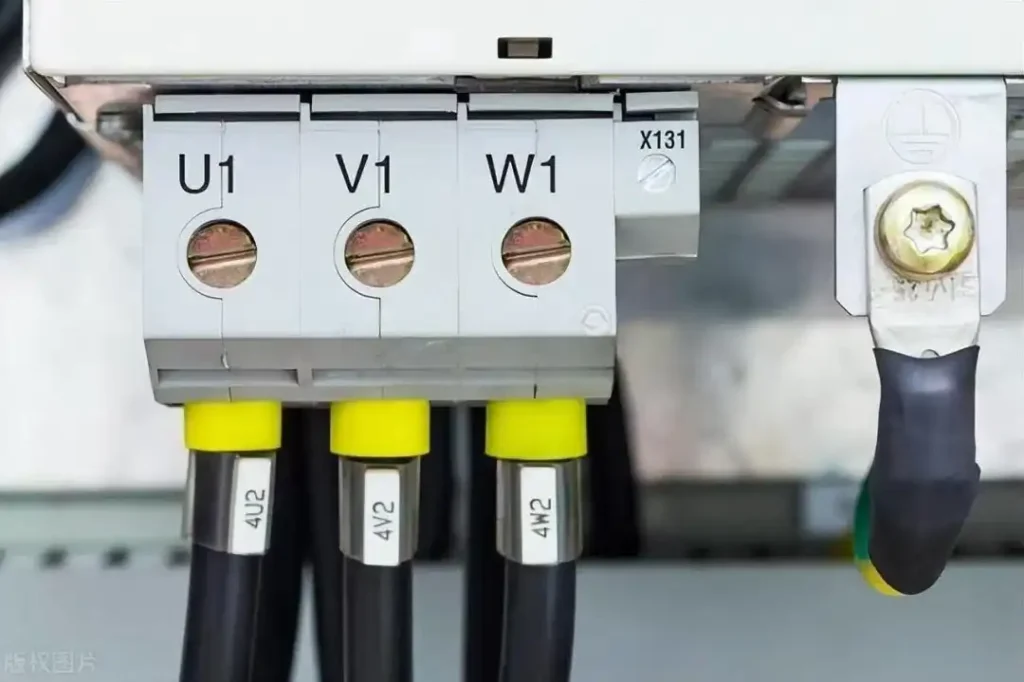
Photo: AC current

DC Motors
These use direct current, where electricity flows steadily in one direction. Batteries or rectified DC power supplies are the primary sources for these motors.

Photo: DC Power

2.2 Efficiency and Performance
Efficiency varies depending on the motor type and operating conditions.

AC Motors
Known for their high efficiency in steady-state conditions, especially induction motors. For example, industrial-grade AC motors can achieve efficiencies of 90–96% under optimal loads.

DC Motors
These excel in applications requiring high torque at low speeds. However, efficiency can drop in brushed models due to friction losses from the brushes and commutator. Brushless DC motors, however, have efficiencies reaching 85–90%.
Take a look at this comparison
| Condition | AC Motor Efficiency | DC Motor Efficiency |
|---|---|---|
| High Load (Steady Speed) | ~92–96% | ~85–90% |
| Low Speed / Variable Load | ~70–80% | ~85% (Brushless DC) |
AC motors shine in large-scale industrial applications with consistent loads, while DC motors are better for dynamic, variable-speed tasks.

2.3 Structural Complexity

AC Motors
These motors are relatively simple in design. The absence of brushes and commutators means fewer moving parts, which translates to less maintenance. For instance, an induction motor’s primary components are the stator, rotor, and housing—straightforward and durable.

Photo: AC Motor Structure

DC Motors
DC motors are more complex. They rely on brushes and a commutator to reverse current direction, ensuring continuous motion. These additional components increase wear and require periodic maintenance, particularly in brushed models.

Photo: DC Motor Structure
In short, AC motors are the easier option for applications prioritizing reliability and minimal upkeep, while DC motors trade simplicity for precise control and versatility.

2.4 Speed Control
Speed control is another area where these motors differ significantly.

AC Motors
Speed control in AC motors depends on the frequency of the supply current. By adjusting this frequency, typically through a variable frequency drive (VFD), you can precisely control the motor’s speed. This is ideal for industrial applications where energy efficiency and flexibility are key.
Input:
AC Power Source
Frequency Adjustment:
Using a Variable Frequency Drive (VFD) to change the input frequency
Effect:
Frequency ↑ → Speed ↑
Frequency ↓ → Speed ↓
Output:
Motor speed adjusts proportionally to frequency
Speed Control Process for AC Motor

DC Motors
DC motors allow more direct control of speed by simply adjusting the supply voltage. In brushed DC motors, changing the voltage directly affects the speed. Brushless DC motors achieve speed control through electronic controllers, which adjust the timing of current delivery to the windings.
Input
DC Power Source
Voltage Adjustment
By varying the supply voltage to the motor
Effect
Voltage ↑ → Speed ↑
Voltage ↓ → Speed ↓
Output
Motor speed changes in direct proportion to voltage
Speed Control Process for DCMotor
Here’s an example: An AC motor paired with a VFD offers fine-tuned control for conveyor belts, while a DC motor’s straightforward voltage-based control is perfect for electric scooters.

2.5 Cost and Maintenance

AC Motors
Upfront Costs
AC motors are generally more affordable upfront, especially for standard induction motors. They are mass-produced and widely used in industrial applications, keeping manufacturing costs low.
Operational Expenses
AC motors are highly energy-efficient in steady-state applications, which keeps long-term operating costs low.
Maintenance Requirements
AC motors require minimal maintenance thanks to their simple design and lack of brushes or commutators.

DC Motors
Upfront Costs
DC motors, particularly brushless ones, tend to cost more due to their complex electronic controllers and additional components.
Operational Expenses
DC motors may consume more power in certain scenarios, especially brushed models that experience friction losses.
Maintenance Requirements
DC motors, especially brushed types, need regular servicing to replace worn brushes and maintain the commutator. Brushless DC motors reduce this burden but still rely on electronic controllers that may require occasional repairs.

2.6 Applications

AC Motors
- Ideal for industrial machinery like conveyor belts, pumps, and fans.
- Widely used in HVAC systems, where consistent, high-efficiency operation is crucial.
- Common in large appliances like washing machines.

Photo: AC Motor is used in industrial machinery

DC Motors
- Perfect for portable tools like drills and electric screwdrivers due to their compact size and torque control.
- Used in electric vehicles, where precise speed and power adjustments are essential.
- Found in robotics for their excellent control and responsiveness.

Photo: DC Motor is used in the industry which needs precise speed control.
Imagine an industrial factory running on AC motors for cost-effective, continuous operation, while a hobbyist’s toolkit relies on DC motors for flexibility and precision
Tip: To get more knowledge about the AC Motor, please read this article.
Tip: To get more knowledge about the DC Motor, please read this article.
Video Resources
Tip: These 2 videos will illustrate the differences between AC & DC Motors.

Quiz: Test Your Knowledge of Part 2: Key Differences Between AC and DC Electric Motors
1. What type of power source does a DC motor use?
- A) Alternating Current (AC)
- B) Direct Current (DC)
- C) Both AC and DC
- D) Solar Power
2. Which motor type generally has a simpler design and requires less maintenance?
- A) AC Motors
- B) Brushed DC Motors
- C) Brushless DC Motors
- D) Stepper Motors
3. How is the speed of an AC motor typically controlled?
- A) By changing the supply voltage
- B) By using a Variable Frequency Drive (VFD)
- C) By adjusting the commutator
- D) By increasing brush friction
4. Which of the following is a major advantage of DC motors?
- A) Low starting torque
- B) Simple speed control through voltage adjustments
- C) High efficiency at constant loads
- D) Minimal maintenance requirements
5. In which application are AC motors most commonly used?
- A) Electric vehicles
- B) Portable power tools
- C) Industrial conveyor belts
- D) Handheld electronics
Learn More about Electric Motors?
LUPMOTORS will send you articles to your Email every week.
100% Free! No Credit Card!

3. Advantages and Disadvantages of AC and DC Motors

3.1 AC Motors
Advantages
-

Low Cost
AC motors are typically cheaper to purchase, especially for standard models like induction motors. Their widespread use in industrial and household applications drives down manufacturing costs.
-

Durability
With fewer moving parts, AC motors are built to last. Their simple structure makes them less prone to wear and tear, reducing the need for frequent repairs.
-

Continuous Operation
AC motors are perfect for applications requiring long-running, steady performance, such as conveyor belts or HVAC systems.
-

Low Starting Power Demand
These motors draw less power during startup, which helps protect connected equipment.
-

Customizable Performance with VFDs
When paired with variable frequency drives (VFDs) or variable speed drives (VSDs), AC motors offer excellent control over speed and torque at different operational stages. This makes them versatile for a wide range of applications.
Disadvantages
-

Low Starting Torque
AC motors generally produce less torque at startup compared to DC motors, which can limit their performance in applications requiring high initial power.
-

Complex Speed Control
Adjusting the speed of an AC motor requires additional equipment like VFDs, which can increase costs and add complexity to the system.

3.2 DC Motors
Advantages
-

High Starting Torque
DC motors excel in delivering a strong initial push, making them perfect for applications that demand high torque at startup, such as cranes or electric winches.
-

Precise Speed Control
Speed in DC motors can be controlled with ease by adjusting the supply voltage. This precision makes them ideal for tasks requiring variable speeds, like robotics and conveyor belts.
-

Simpler Installation and Maintenance (Brushless Models)
Brushless DC motors eliminate the need for brushes and commutators, reducing wear and tear and making installation and upkeep easier compared to brushed models.
-

Fast Response Times
DC motors offer quick acceleration, deceleration, and smooth starts and stops, making them a favorite in dynamic applications like electric vehicles.
Disadvantages
-

Complex Maintenance (Brushed Models)
Brushed DC motors require frequent maintenance, such as replacing worn brushes and maintaining the commutator. This can be a drawback for applications that demand long-term reliability.
-

Complex Speed Control
Adjusting the speed of an AC motor requires additional equipment like VFDs, which can increase costs and add complexity to the system.
The table summarizing the advantages and disadvantages of DC motors
| Advantages of DC Motors | Disadvantages of DC Motors |
|---|---|
| High starting torque, ideal for heavy-load applications | Higher initial cost, especially for brushless motors |
| Precise speed control by adjusting supply voltage | Brushed motors require regular maintenance (brush wear) |
| Fast response times for quick start, stop, and acceleration | Complex design in brushed motors (commutators & brushes) |
| Compact size and lightweight (especially brushless motors) | Electronic controllers in brushless motors add complexity |
| Suitable for battery-powered and portable applications | Limited efficiency in older brushed models due to friction |

4. AC Motor or DC Motor: Which One Do I Need?
Choosing the right motor for your industrial setup can make all the difference in performance and efficiency. Now that you understand the key differences between AC and DC motors, it’s time to evaluate your specific requirements. Let’s break it down.

When to Choose an AC Motor
Continuous Operation
If your application involves steady, long-term operation, such as powering conveyor belts or fans, AC motors are your best bet. Their durability and low maintenance make them ideal for such tasks.
Cost Sensitivity
AC motors are generally more affordable upfront. They’re a practical choice if your budget is tight but reliability is crucial.
Available Grid Power
AC motors work seamlessly with grid electricity. If your facility is connected to a reliable power supply, an AC motor will integrate smoothly.
Speed Flexibility with VFDs
For processes requiring variable speeds, like HVAC systems, an AC motor paired with a VFD offers precise control and efficiency.

When to Choose an DC Motor
High Starting Torque Needs
DC motors excel in tasks that demand a powerful start, such as operating cranes or electric winches.
Portable or Battery-Powered Applications
If your setup relies on batteries, such as in electric vehicles or portable tools, DC motors are the natural choice.
Precise Speed and Torque Control
For tasks requiring high precision, like robotics or production line automation, DC motors shine due to their voltage-based speed adjustments.
Dynamic Applications
DC motors handle frequent starts, stops, and speed changes effortlessly, making them ideal for electric scooters or robotic arms.
Quick Tip: If your operation requires cost efficiency and minimal maintenance, stick with AC motors. For precision, torque, and flexibility, DC motors are the way to go. Evaluate your workload, power source, and control needs before purchasing.

5. Latest Technological Advancements
Innovations in AC Motors: Variable Frequency Drives (VFDs)

Photo: VFD System
AC motors have come a long way with the introduction of Variable Frequency Drives (VFDs). These devices allow precise control of motor speed by adjusting the frequency of the electrical supply.
For example, in HVAC systems, VFDs help regulate airflow and reduce energy consumption by up to 30%. In industrial processes, they enhance efficiency by matching motor speed to workload demands, minimizing waste.
Another advancement is the integration of IoT-enabled VFDs. These systems allow real-time monitoring and control via cloud platforms, improving operational reliability.
Advancements in DC Motors: Brushless Technology for Electric Vehicles (EVs)
DC motors have seen significant progress, particularly in the form of Brushless DC (BLDC) motors. Unlike traditional brushed motors, BLDC motors use electronic controllers to switch current, eliminating the need for brushes and commutators.
This innovation offers several advantages:
- Higher Efficiency: BLDC motors reach efficiencies of up to 90%, reducing energy waste.
- Longevity: Fewer moving parts mean less wear and tear, making them more durable.
- Compact Design: Their lightweight and compact structure is perfect for electric vehicles and drones.
In the EV market, BLDC motors are essential for powering everything from Tesla cars to e-scooters, where precision and efficiency are critical.

6.Real-World Applications and Case Studies
Industrial Example: Why AC Motors Dominate Factory Production Lines

Photo: A motor are working on the production line
AC motors are the backbone of industrial production. Their reliability and low operational costs make them indispensable for factory operations. For example, in conveyor systems, AC induction motors are used for their durability and ability to run continuously without overheating.
Their compatibility with Variable Frequency Drives (VFDs) allows factories to optimize motor speed based on workload, improving efficiency. Additionally, the simple design of AC motors reduces maintenance downtime, a critical factor for high-output facilities.
Consumer Electronics Example: How DC Motors Are Used in Compact and Portable Devices
DC motors shine in portable and compact devices due to their ability to provide high torque in small sizes. Think about your electric toothbrush, handheld vacuum, or even drones. These devices rely on Brushless DC (BLDC) motors for their lightweight design, efficiency, and quiet operation.
For instance, BLDC motors in drones deliver the precise control needed for stable flight and fast directional changes. Their compact size also allows manufacturers to pack more functionality into smaller devices.
These examples highlight how AC and DC motors power everything from factories to personal devices. By understanding their strengths, you can see why each motor type plays a unique role in shaping modern technology.

8. FAQs
What are the main differences between AC and DC motors?
- AC motors use alternating current and are simpler in design, making them ideal for continuous and large-scale applications.
- DC motors rely on direct current and are preferred for portable or dynamic tasks due to their high starting torque and precise speed control.
How do I choose between an AC and a DC motor?
Evaluate your application needs:
- Choose AC motorsfor durability, cost-efficiency, and steady, long-term operation in industrial or HVAC systems.
- Choose DC motorsfor high torque, precision control, or battery-powered setups like electric vehicles and robotics.
Which motor type is more efficient in different applications?
- AC motors excel in steady-speed applications, achieving up to ~96% efficiency in industrial machinery.
- DC motors are more efficient for variable-speed tasks, especially brushless models, which reach efficiencies of ~85–90%.
What are the maintenance challenges for each type?
- AC Motors:Minimal maintenance due to their simple structure and lack of brushes or commutators.
- DC Motors:Brushed models require frequent servicing to replace brushes and maintain commutators. Brushless DC motors reduce this burden significantly but may require occasional electronic controller maintenance.
We offer customized motor solutions to meet your specific application requirements
LUPMOTORS offers ac low voltage 3-phase asynchronous industrial motors of all types – Please contact us freely.

A Selection Guide for Explosion Proof Motors
Learn how to choose the right explosion-proof motor for hazardous locations. Understand classifications, T-Codes, and certifications to ensure safety and compliance!

Structure of Electric Motors | The Complete Guide
Discover the structure of electric motors, from stators and rotors to windings and bearings. Learn how materials impact efficiency, performance, and lifespan!

Motor Thermal Overload Protection | The Complete Guide
“Discover how motor thermal overload protection works, why it matters, and how to choose the right protector. Plus, take our quiz to test your knowledge!”
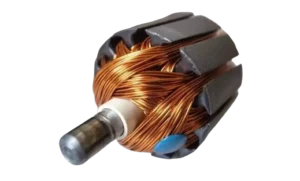
Brushed Motors vs. Brushless Motors: The Complete Guide
“Explore brushed vs. brushless motors: key differences, pros, cons, and which one fits your needs best!”

How to Test an Electric Motor: Tools, Methods & Procedures
Learn how to test electric motors with expert tools and methods. Discover step-by-step guides for insulation, resistance, and running current tests to ensure peak performance!

NEMA Motors vs IEC Motors: The Definitive Guide
“Explore the ultimate guide to NEMA vs. IEC motors. Learn key differences, efficiency standards, applications, and choose the right motor for industrial success.”














